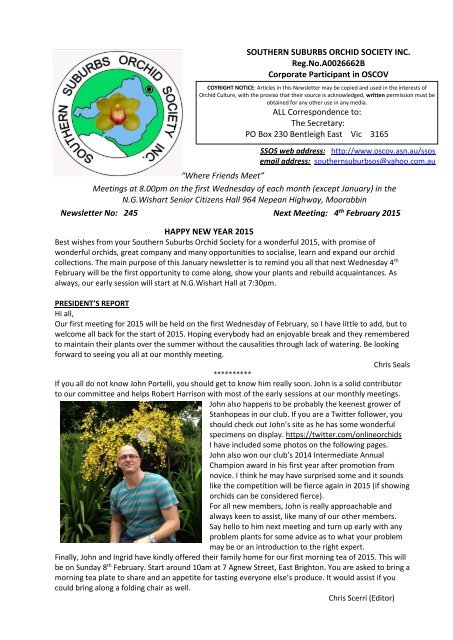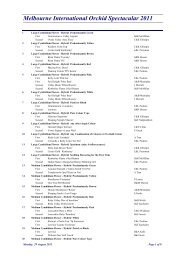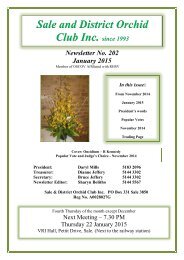NEWSLETTER - Orchid Societies Council of Victoria Inc
NEWSLETTER - Orchid Societies Council of Victoria Inc
NEWSLETTER - Orchid Societies Council of Victoria Inc
You also want an ePaper? Increase the reach of your titles
YUMPU automatically turns print PDFs into web optimized ePapers that Google loves.
\<br />
SOUTHERN SUBURBS ORCHID SOCIETY INC.<br />
Reg.No.A0026662B<br />
Corporate Participant in OSCOV<br />
COYRIGHT NOTICE: Articles in this Newsletter may be copied and used in the interests <strong>of</strong><br />
<strong>Orchid</strong> Culture, with the proviso that their source is acknowledged, written permission must be<br />
obtained for any other use in any media.<br />
ALL Correspondence to:<br />
The Secretary:<br />
PO Box 230 Bentleigh East Vic 3165<br />
SSOS web address: http://www.oscov.asn.au/ssos<br />
email address: southernsuburbsos@yahoo.com.au<br />
“Where Friends Meet”<br />
Meetings at 8.00pm on the first Wednesday <strong>of</strong> each month (except January) in the<br />
N.G.Wishart Senior Citizens Hall 964 Nepean Highway, Moorabbin<br />
Newsletter No: 245 964 Nepean Highway, Moorabbin Next Meeting: Vic. 4 th February 2015<br />
HAPPY NEW YEAR 2015 2012<br />
Best wishes from your Southern Suburbs <strong>Orchid</strong> Society for a wonderful 2015, with promise <strong>of</strong><br />
wonderful orchids, great company and many opportunities to socialise, learn and expand our orchid<br />
collections. The main purpose <strong>of</strong> this January newsletter is to remind you all that next Wednesday 4 th<br />
February will be the first opportunity to come along, show your plants and rebuild acquaintances. As<br />
always, our early session will start at N.G.Wishart Hall at 7:30pm.<br />
PRESIDENT’S REPORT<br />
Hi all,<br />
Our first meeting for 2015 will be held on the first Wednesday <strong>of</strong> February, so I have little to add, but to<br />
welcome all back for the start <strong>of</strong> 2015. Hoping everybody had an enjoyable break and they remembered<br />
to maintain their plants over the summer without the causalities through lack <strong>of</strong> watering. Be looking<br />
forward to seeing you all at our monthly meeting.<br />
Chris Seals<br />
**********<br />
If you all do not know John Portelli, you should get to know him really soon. John is a solid contributor<br />
to our committee and helps Robert Harrison with most <strong>of</strong> the early sessions at our monthly meetings.<br />
John also happens to be probably the keenest grower <strong>of</strong><br />
Stanhopeas in our club. If you are a Twitter follower, you<br />
should check out John’s site as he has some wonderful<br />
specimens on display. https://twitter.com/onlineorchids<br />
I have included some photos on the following pages.<br />
John also won our club’s 2014 Intermediate Annual<br />
Champion award in his first year after promotion from<br />
novice. I think he may have surprised some and it sounds<br />
like the competition will be fierce again in 2015 (if showing<br />
orchids can be considered fierce).<br />
For all new members, John is really approachable and<br />
always keen to assist, like many <strong>of</strong> our other members.<br />
Say hello to him next meeting and turn up early with any<br />
problem plants for some advice as to what your problem<br />
may be or an introduction to the right expert.<br />
Finally, John and Ingrid have kindly <strong>of</strong>fered their family home for our first morning tea <strong>of</strong> 2015. This will<br />
be on Sunday 8 th February. Start around 10am at 7 Agnew Street, East Brighton. You are asked to bring a<br />
morning tea plate to share and an appetite for tasting everyone else’s produce. It would assist if you<br />
could bring along a folding chair as well.<br />
Chris Scerri (Editor)
Showing your plants<br />
We really, really want all <strong>of</strong> you to bring as many flowering plants as possible for showing at our<br />
monthly meetings. I know that I only started showing during the last year or so and I know it can be a<br />
little intimidating when you start. Thomas Edison has been quoted as saying:<br />
“I have not failed 700 times. I have not failed once. I have succeeded in proving that those 700 ways will<br />
not work. When I have eliminated the ways that will not work, I will find the way that will work.”<br />
I assure you that you will not fail 700 times but even a genius like Edison recognised the importance <strong>of</strong><br />
trial and error. Here are a few hints about how you should label your plants but do not worry as<br />
someone in the room will help you out. We all want to see your plants, starting this week.<br />
Plant Name Tags When Benching Plants at SSOS Member Meetings<br />
Make sure each plant entered for showing has a correctly labelled plant name tag<br />
Blank plant name tags are available at the venue<br />
Make sure completed plant name tags are readable<br />
Completed name tag should be for relevant section<br />
o Open: Pink<br />
o Intermediate: Yellow<br />
o Novice: White<br />
<br />
<br />
<br />
For members showing in the Open Section:<br />
o Missing, incorrectly labelled or unreadable plant name tags will result in the<br />
plants not being judged<br />
For members showing in the Intermediate and Novice Sections, the club is a little more<br />
lenient as we want to encourage all to learn:<br />
o Plants that have missing, incorrectly labelled or unreadable plant name tags will<br />
be judged (at discretion <strong>of</strong> the show marshal) but you must put your name on the<br />
tag if we are to allocate points to you.<br />
Note:<br />
o If not sure or need some advice on how to correctly fill out the plant name tag,<br />
ask for advice from the Show Marshall or other members.<br />
Front<br />
o Any flowering orchid on show will still be appreciated by all the members but<br />
missing, incorrectly labelled or unreadable plant name tags could mean no<br />
flowering competition points being awarded<br />
Where Friends meet<br />
Example: Completed Plant Name Tag<br />
Intermediate<br />
Class: Intermediate Cymbidium<br />
Name <strong>of</strong> plant: Sleeping Sarah “lovely” x<br />
Paradisian Bullseye<br />
Owner’s Name:<br />
Date: 20 / 3 / 2013<br />
Reverse<br />
Andy Willwin
Summer is the time for Stanhopeas<br />
As promised, I have included a few photos here <strong>of</strong> just a few <strong>of</strong> John Portelli’s beautiful Stanhopeas.<br />
You have to admire<br />
the wonderful<br />
Stanhopea<br />
nigroviolacea in<br />
these photos left and<br />
right. Aroma <strong>of</strong><br />
chocolate and vanilla<br />
just adds to the<br />
senses invaded by<br />
this orchid.<br />
Below left is S. lietzei<br />
and S, hernandezii in<br />
the background.<br />
Below right is John’s<br />
Stanhopea Corner in<br />
his East Brighton<br />
backyard.<br />
OSCOV operates a wonderful website with a wealth <strong>of</strong> information. I found this article which might<br />
surprise some <strong>of</strong> us about the ability <strong>of</strong> cymbidiums to flower at different times <strong>of</strong> the year. I thought<br />
this to be a good article, despite its vintage, for the start <strong>of</strong> this year so we can really plan ahead.<br />
From OSCOV website, written by Stephen Early in 2000. http://www.oscov.asn.au/articles.html<br />
CYMBIDIUM SPECIES -MONTH by MONTH by Stephen Early<br />
I have <strong>of</strong>ten heard cymbidium hybridisers claim that they will soon have cymbidium hybrids that will<br />
flower all year round. But this is possible now with a collection <strong>of</strong> cymbidium species, so where is the<br />
big change? All the plants I describe in this article are ones that I grow and that are available in<br />
<strong>Victoria</strong>. Unless stated otherwise, they will grow and flower without heat in Melbourne.<br />
In January and February not many orchids are in flower but several <strong>of</strong> the thick-leafed cymbidiums<br />
are usually in bloom. One is Cymbidium aloifolium, the type species for the genus (which means that<br />
it was the first cymbidium described). It is appropriate that it should be the first species to flower,
together with Cymbidium finlaysonianum, C. bicolor, C. atropurpureum and C. rectum. All <strong>of</strong> these<br />
species require heat and we therefore grow them with our cattleyas. Their need for heat is not<br />
surprising because they grow in the lowlands <strong>of</strong> Asia, <strong>of</strong>ten in full sunshine. However, C. suavissimum,<br />
which can be grown without heat, also flowers at this time. It is closely related to C. floribundum but<br />
it has upright spikes and produces its flowers about three months later than C. floribundum.<br />
In March and April C. lancifolium comes into flower. Also known as C. aspidistrifolium, it forms a<br />
small plant with tapered leaves. Growing in leaf litter on the forest floor, each bulb develops on an<br />
ascending rhizome so that the plant is continually raised above the accumulation <strong>of</strong> leaf litter. Due to<br />
the altitude at which this plant grows in nature (up to 2300 m) it will grow cold in Melbourne.<br />
In April and May a number <strong>of</strong> cymbidium species are in flower. One <strong>of</strong> my favourites is C. dayanum,<br />
which grows cold and is <strong>of</strong>ten still in bloom in July. It makes a good specimen in a 125 - 150 mm pot<br />
and produces a series <strong>of</strong> spikes over several months. Another species that flowers in April and May is<br />
C. erythraeum, its smaller plant size and flowers resembling those <strong>of</strong> C. iridioides.<br />
The distinctive bell-shaped flowers <strong>of</strong> C. elegans, a strikingly different species, appear in May and<br />
June. C. erythrostylum also flowers at this time - it's an outstanding species with white flowers and<br />
makes a charming specimen plant. It is an important parent in the breeding <strong>of</strong> many early-flowering<br />
standard cymbidiums.<br />
In July C. tracyanum begins to flower and continues to produce its twisted, reflexed and highly<br />
scented flowers in light and dark brown shades until August. Its flowers have about every fault the<br />
judges would penalise in a cymbidium hybrid. C. iridioides (<strong>of</strong>ten known as C. giganteum) also flowers<br />
at this time. It is sometimes confused with C. tracyanum, even though both the plant and its flowers<br />
are quite different.<br />
Come August and September and one <strong>of</strong> the gems <strong>of</strong> the orchid world, C. hookerianum, <strong>of</strong>ten known<br />
by its synonym, C. grandiflorum, comes into flower. It has celery-green foliage and large green<br />
flowers. Unfortunately many plants labelled as C. hookerianum are early hybrids but once you have<br />
seen the real species then the impostors are easy to pick. C. insigne flowers in September. Its flowers<br />
vary from pink to white; you can easily recognise its influence in many early standard cymbidium<br />
hybrids.<br />
In September and October we see the flowers <strong>of</strong> C. sanderae, <strong>of</strong>ten also called C. parishii, although<br />
this is now thought to be a different species. C. sanderae has large spikes <strong>of</strong> cream - white flowers<br />
with heavily marked lips.<br />
From September through to November you can see C. lowianum in flower. This is a large plant with<br />
long, arching spikes carrying many flowers, which are usually green, although a yellow form has been<br />
found. I have purchased many plants and later discarded them because <strong>of</strong> questionable leaf markings.<br />
Finding disease-free plants can be difficult because most plants <strong>of</strong> this species have been in cultivation<br />
for many years.<br />
In October we have C. floribundum in flower. Also known as C. pumilum, this miniature species has<br />
been used to breed most miniature and intermediate cymbidium hybrids. Because <strong>of</strong> its small plant<br />
and small flowers, it makes an excellent specimen plant. At this time <strong>of</strong> year C. devonianum also<br />
flowers. It is also used to produce miniature- and intermediate-sized hybrids. It has large strap-like<br />
leaves and produces small flowers on pendulous spikes. In my experience C. devonianum grows best<br />
with a little heat in winter.<br />
During November and December the Australian<br />
cymbidium species, C. suave, C. madidum and C.<br />
canaliculatum begin to flower. Only the first <strong>of</strong> these<br />
three species grows well in Melbourne without winter<br />
heat.<br />
As you have seen, a collection <strong>of</strong> species<br />
cymbidiums will provide flowers all year round. With<br />
the exception <strong>of</strong> January and February you can do<br />
this with cool-growing plants. All <strong>of</strong> the species<br />
mentioned in this article have been collected in<br />
Melbourne by us over the last few years and are not<br />
uncommon. I have not mentioned those species that<br />
we have as yet to grow or flower successfully.





